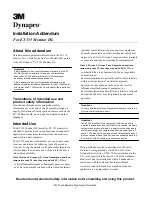
4/2
Beim V-Schalter 3AH1 mit Unterspannungsauslöser
(Y7) 3AX1103 ist zusätzlich die Arretierungsschraube des
Schlagbolzens von Stellung A nach B zu versetzen.
5. Zum Probeschalten mit Motorantrieb ist die Versorgungs-
spannung einzuschalten. Der Motorantrieb läuft sofort
an und spannt die Einschaltfeder (62.). Anzeige für den
Spannungszustand der Einschaltfeder (mechanisch und
elektrisch) prüfen. Antrieb wie unter 4. angegeben betäti-
gen und dabei die mechanische und elektrische Schalt-
stellungsmeldung kontrollieren.
6. Hilfsschalter S1 (68.) und Positionsschalter (50.4.1) in
beiden Endstellungen elektrisch durchprüfen – hierzu den
V-Schalter 3AH1 betätigen.
7. Die Funktion des Einschaltmagneten Y9 (53.1) und aller
vorhandenen Arbeitsstromauslöser durch elektrische Be-
tätigung überprüfen.
8. Das Abdeckblech (60.1) des Antriebskastens ist mit vier
Schrauben (60.1.1) befestigt. Bei der Inbetriebnahme ist
zu beachten, daß ein Anziehdrehmoment von 10 Nm
eingehalten wird.
Nach Feststellung der einwandfreien Funktionsbereitschaft
kann der V-Schalter 3AH1 in Betrieb gesetzt werden.
Spannen der Einschaltfeder
Bei anliegender Versorgungsspannung wird die Einschaltfe-
der (62.) automatisch durch den Motor (50.4) gespannt. Bei
Ausfall der Versorgungsspannung kann die Einschaltfeder
(62.) mit der Handkurbel (50.) gespannt werden. In letzterem
Fall, wie in Fig. 4/1 dargestellt, die Handkurbel (50.) mit nach
vorn geschobenem Adapter (50.6) durch die Öffnung (50.1)
auf die Handkurbelkupplung (50.5) stecken und im Uhrzei-
gersinn drehen, bis in der Anzeigeöffnung (55.3) das Symbol
„Einschaltfeder entspannt“ auf „Einschaltfeder gespannt“ um-
schaltet (Fig. 4/2).
Der Adapter (50.6) der Handkurbel (50.) ist so gestaltet, daß
bei Wiederkehr der Motor-Versorgungsspannung die Hand-
kurbel entkuppelt wird.
On the 3AH1 V-breaker with undervoltage release (Y7)
3AX1103, the arresting screw of the hammer must be
moved from position A to B.
5. For test operations with the motor mechanism switch on
the supply voltage. The motor will start immediately and
charge
the closing spring (62.). Check the mechanical
and electrical indication of the charging state of the closing
spring. Actuate the mechanism as indicated under 4. and
check the mechanical and electrical state indication.
6. Check the auxiliary switch S1 (68.) and position switches
(50.4.1) electrically in both end positions by actuating the
3AH1 vacuum breaker.
7. Also check - by electrical actuation - the function of the
closing solenoid Y9 (53.1) and all fitted shunt releases.
8. The cover (60.1) of the mechanism housing is fixed by four
bolts (60.11). When commisioning, check that a tightening
torque of 10 Nm has been observed.
When correct functioning of the 3AH1 V-breaker has been
ascertained it can be put into service.
Charging the closing spring
When the supply voltage is applied the motor (50.4) automat-
ically charges the closing spring (62.). Should the supply fail
the closing spring (62.) can also be charged by hand crank
(50.). In the lattercase, as shown in Fig. 4/1, the hand crank
(50.) is inserted with the forwards pushed adapter (50.6)
through the opening (50.1) onto hand crank coupling (50.5)
and turned clockwise, until the symbol “Closing spring dis-
charged” shown in the indicator opening (55.3) is changed to
“Closing spring charged” (Fig. 4/2).
The adapter (50.6) is designed so that the hand crank (50.) is
decoupled on the recovery of the motor supply.
50.1
55.3
53.
54.
50.
Fig. 4/1
Spannen der Einschaltfeder mittels Handkurbel
Charging the closing spring with the hand crank
50.
50.5
50.6









































